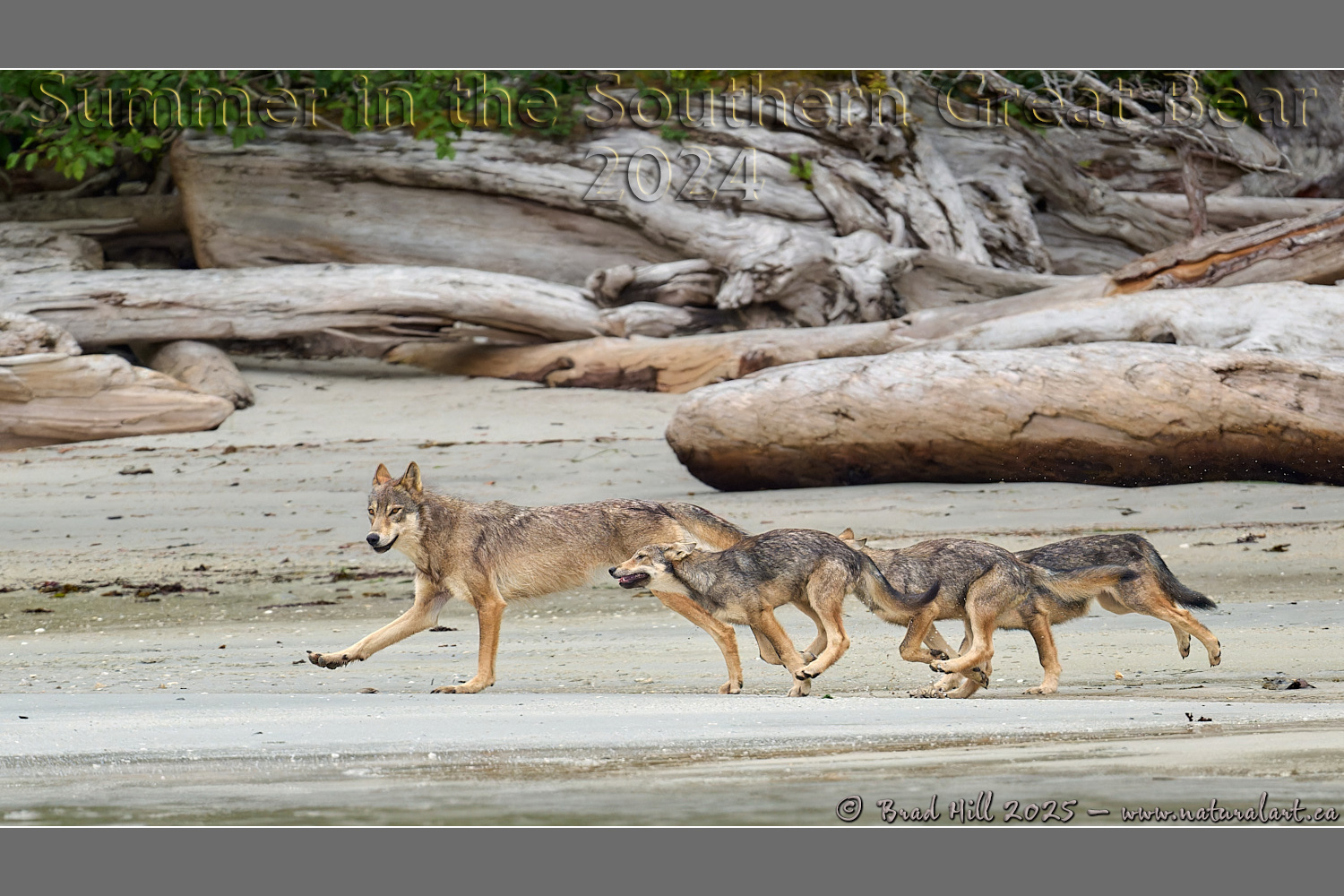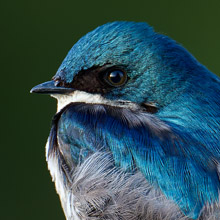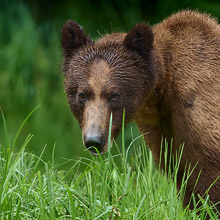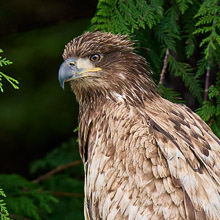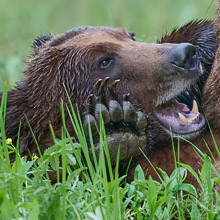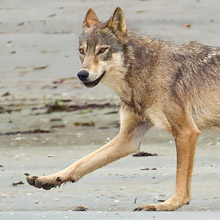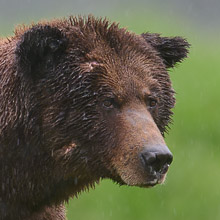Availability: Undetermined - Enquiries?
In the Field
Follow the Leader - Gray Wolf Style! Great Bear Rainforest, British Columbia, Canada. August 24, 2024.
Nope, this isn't a coastal Gray Wolf being chased by a 12-legged...uhhhh...something (monster?). It's Dad wolf being chased along a remote beach in the Great Bear Rainforest by three of his four pups after he had returned back to the pups after a hunting trip. The pups had been left at a safe rendezvous site. I have to admit that when I captured this image I had no idea if the pups were just excited to see dad or if they were just darned hungry and were anticipating a hot meal of regurgitated meat! But it really looked like they were having a ton of fun! 😉
This encounter with a small family group (AKA "pack") of coastal Gray Wolves didn't last too long (it was just a little over 10 minutes from my first image capture of the encounter through to my final image capture). But during those 10 minutes we saw just so, so much fascinating wolf behaviour - and captured so many compelling (and bucket list!) images - that I rate it as one of my most memorable wildlife encounters EVER!
This image - along with all the other images captured during this wolf session - was captured with a Nikon Z 9 paired with the Nikkor Z 800mm f6.3S prime lens. If I'm being honest I have to say I don't use my Z 800mm a ton, and certainly less than my other prime super-telephoto (my Nikkor Z 400mm f2.8S). BUT, when the situation demands it (like in this wolf encounter), the Z 800mm f6.3S is almost worth its weight in gold! Note that I said "almost"! 😉
This memorable coastal Gray Wolf encounter, combined with our success over the past few years finding wolves in specific locations, convinced me to offer a Great Bear Rainforest photo tour focused on wolves for summer 2026. And, we recently (in early July 2025) decided to offer the wolf photo tour again in 2027! The 2026 wolf photo tour sold out almost instantly. While sold out, I am still accepting names on the waiting/cancellation list for this photo tour - just go here to learn more about the photo tour and how to join the waiting list for it: 10-Day Summer in the Great Bear: Focused on WOLVES!
What about the 2027 wolf photo tour? At this point I don't have enough details (specifically final price and dates) to begin taking registrations. But you CAN join the Priority Booking List (which is a no-commitment "first right of refusal" list) - just go here to find out how!
Here's a larger version (4800 pixel) of this frolicking family of coastal Gray Wolves:
• Follow the Leader - Gray Wolf Style: Download 4800 pixel image (JPEG: 4.5 MB)
ADDITIONAL NOTES:
1. These images - in all resolutions - are protected by copyright. I'm fine with personal uses of them (including use as desktop backgrounds or screensavers on your own computer), but unauthorized commercial use of the image is prohibited by law. Thanks in advance for respecting my copyright!
2. Like all photographs on this website, these images were captured following the strict ethical guidelines described in The Wildlife FIRST! Principles of Photographer Conduct. As such, no baiting or any form of attractant was used and, as always, we attempted to minimize our impact on the ongoing behaviour of the subjects. I strongly encourage all wildlife photographers to always put the welfare of their subjects above the value of their photographs.
3. This image was captured during my Summer in the Southern Great Bear Exploratory Photo Adventure in the summer of 2024. Each year I offer photo tours into the Great Bear Rainforest and, every other year, photo tours into the Khutzeymateen Grizzly Sanctuary (to photograph grizzlies, of course!). Details about these trips can be found on the Photo Tours page of this website.
Behind the Camera
Follow the Leader - Gray Wolf Style! Great Bear Rainforest, British Columbia, Canada. August 24, 2024.
High Efficiency* Compressed RAW (NEF) format; ISO 1600.
Nikon Z 9 paired with Nikkor Z 800mm f6.3S. Hand-held from a floating Zodiac inflatable boat. VR on in Sport mode. 3D-tracking AF area mode with subject detection on "Bird" mode.
1/1250s @ f6.3; No compensation from matrix-metered exposure setting.
At the Computer
Follow the Leader - Gray Wolf Style! Great Bear Rainforest, British Columbia, Canada. August 24, 2024.
Initial noise reduction and capture sharpening on the .nef (raw) file using the DeepPRIME XD2S algorithm of DXO PhotoLab 8.7 Elite (using the appropriate lens/camera optical module).
Subsequent adjustments to the adjusted linear DNG file (exported from PhotoLab) and conversion to 16-bit TIFF file (and JPEG files for web use) - including all global and selective adjustments - made using Capture One Pro (build 16.6.3). In the case of this image the global adjustments included a tweak to the highlights, brightness (mid-tone exposure) and an overall contrast adjustment (via the Levels tool). Selective local adjustments performed using Capture One Pro's layers and masking tools. In this case numerous small adjustments and minor tweaks were made on 3 separate layers, with the tweaks being associated with "exposure balancing" and contrast adjustments (such as adjustments to brightness, clarity, highlights, shadows, etc.).
Photoshop modifications included insertion of the watermark and/or text.
Conservation
Follow the Leader - Gray Wolf Style! Great Bear Rainforest, British Columbia, Canada. August 24, 2024.
Species Status in Canada*: Only Eastern Wolf listed as species of "Special Concern" in May, 2001. Other populations not listed as Endangered or Threatened.
Probably no species alive today has suffered as much direct persecution from humans as has the Gray Wolf (Canis lupus). Once extremely widespread in North America, the Gray Wolf was virtually extirpated from the contiguous 48 states of America and now is regularly found within only a fraction of its historical range in Canada. While the Gray Wolf is currently listed as endangered in most of the 48 lower states of the United States and enjoys the privileges associated with such status (if lack of persecution and abuse can be thought of as a privilege), it is still official policy in much of Canada to rid the countryside of this magnificent keystone predator. As an example, in British Columbia, there is NO closed season on the wolf in most hunting jurisdictions and opportunistic slaughter is encouraged by policy (it is the ONLY fur-bearing species for which NO species hunting tag is required in British Columbia!). Conservation of wolves presents a puzzling paradox. Reduced to the most basic principles, wolf conservation is simplistic: we need only to stop persecuting this species in order for it to survive. Yet accomplishing this invariably proves incredibly difficult - it's as though wolf persecution has been institutionalized directly into government (and societal) bureaucracy.
*as determined by COSEWIC: The Committee on the Status of Endangered Wildlife in Canada













